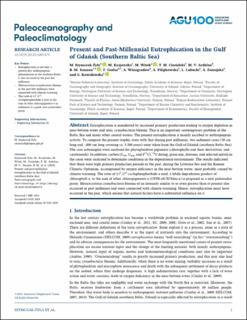Present and Past‐Millennial Eutrophication in the Gulf of Gdańsk (Southern Baltic Sea)
Szymczak-Zyla, Malgorzata; Krajewska, Magdalena; Witak, Małgorzata; Ciesielski, Tomasz Maciej; Ardelan, Murat Van; Jenssen, Bjørn Munro; Goslar, Tomasz; Winogradow, Aleksandra; Filipkowska, Anna; Lubecki, Ludwik; Zamojska, Anna; Kowalewska, Grażyna
Peer reviewed, Journal article
Published version
Permanent lenke
https://hdl.handle.net/11250/2650442Utgivelsesdato
2019Metadata
Vis full innførselSamlinger
- Institutt for biologi [2612]
- Publikasjoner fra CRIStin - NTNU [38576]
Sammendrag
Eutrophication is manifested by increased primary production leading to oxygen depletion in near‐bottom water and toxic cyanobacteria blooms. This is an important contemporary problem of the Baltic Sea and many other coastal waters. The present eutrophication is mainly ascribed to anthropogenic activity. To compare the present trophic state with that during past millennia, two sediment cores (50 cm long and ~400 cm long covering ca. 5,500 years) were taken from the Gulf of Gdańsk (southern Baltic Sea). The core subsamples were analyzed for phytoplankton pigments (chlorophylls and their derivatives, and carotenoids). In addition, carbon (Ctot, Corg, and δ13C), 14C dating, grain size, diatoms, and selected metals in the cores were analyzed to determine conditions in the depositional environment. The results indicated that there were high primary production periods in the past, during the Littorina Sea and the Roman Climatic Optimum, accompanied by oxygen deficiency in the near‐bottom water, most probably caused by climate warming. The ratio of 132,173‐cyclopheophorbide‐a enol, a labile degradation product of chlorophyll‐a, to the sum of other chloropigments‐a (CPPB‐aE/ΣChlns‐a) is proposed as a new paleoredox proxy. Heterocystous cyanobacteria blooms of an intensity similar to or even greater than at present also occurred in past millennia and were connected with climate warming. Hence, eutrophication must have occurred in the past, which means that natural factors have a substantial influence on it.
